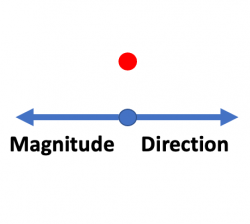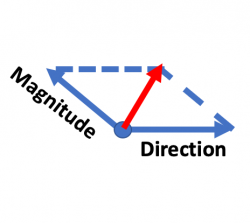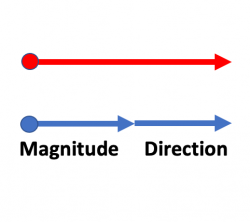Sunday, November 28, 2021

“Speakers who talk about what life has taught them never fail to keep the attention of their listeners.”
– Dale Carnegie
I went to undergraduate school at the New Jersey Institute of Technology, where I earned my bachelor of science degree in electrical engineering. The campus newspaper was called “The Vector.” The subtitle was “With Magnitude and Direction.”
Does your speaking have magnitude and direction?
This article will describe what they mean for your speaking and why it is crucial to have both.
Your Speaking Magnitude
The magnitude of your speaking is the amount of emphasis you put on different parts of your presentation. Your speaking must have magnitude to affect your audience positively. Without magnitude, your presentation will be blah with your audience.
Magnitude also means you are excited about your subject when you are delivering your presentation. Of course, there are no guarantees your audience will be excited about your presentation if you are. However, it is guaranteed your presentation will underwhelm your audience if you are not excited about it.
Some examples of magnitude in your speaking are
Raising the volume and pitch of your voice with animated body language
Using appropriate facial expressions timed to coincide with the point you are making
Using descriptive language while making their points
It is essential your speaking incorporate magnitude to establish and maintain audience engagement.
It is uncomfortable to witness a speaker who raises the volume and pitch of their voice with animated language, uses appropriate facial expressions timed to coincide with the point they are making, and uses descriptive language to make their points, but does not build main point upon main point to give their presentation direction.
Your Speaking Direction
The direction of your speaking is like giving your audience hangers to which to hang your speaking thoughts. These hangers are related and build upon the preceding and aids the following main points.
In other words, you are showing as you deliver your presentation the direction of your presentation. This is important because confusing your audience is a distraction that will keep them from absorbing your main message.
You may have heard the following expression concerning how to deliver a presentation: “Tell them what you will tell them. Tell them. Tell them what you told them.” It sounds simple, but most things in life that work are simple.
So tell your audience upfront what your direction is by telling them your presentation’s main points, how they relate to each other, and your overall message. Then, the rest of your presentation supports what you told them you would tell them.
Finally, in your closing, tell them what you told them, tell them how they can apply what you told them to their personal and professional lives, and then finish with a pertinent short story (personal story if possible), startling statistic, or pertinent quote. Then, get off the stage.
Magnitude and direction separately are essential methods when you deliver presentations. However, their combination is the most powerful way you can deliver a presentation to change your audience members’ thinking to your own, keep your audience’s distractions to a minimum, and positively change your audience members’ personal and professional lives (read, they will apply what you have said).
Why Your Speaking Needs Both Magnitude and Direction
The field of engineering uses mathematical vectors extensively. Mathematical vectors are forces that have magnitude and direction. You can say that your speaking magnitude and direction can be looked upon as engineering vectors. We can then graphically illustrate the importance of how your mutually supporting speaking magnitude and direction affect your audience.

When your speaking magnitude and direction are not supporting each other, you have a weak presentation that will not come close to convincing the audience of your message, your audience will be distracted during your message delivery, and your audience will not apply your message in their personal and professional lives.

When your speaking magnitude and direction are not diametrically opposite, you have a viable but still weak presentation. For example, a minority of your audience’s members might be convinced of your message if they can understand it, a majority of your audience’s members will be distracted during your message delivery, and a majority of your audience’s members will not apply your message to their personal and professional lives.

When your speaking magnitude and direction completely support and complement each other, you have a strong presentation. The majority of your audience’s members will be convinced of your message if they can understand it, your audience’s members will not be distracted during your message delivery, and the majority of your audience’s members will apply your message to their personal and professional lives.
So, now you know how essential mutually supporting magnitude and direction in your presentations are vital to your message getting through to your audience and having them apply it in their personal and professional lives.
Does your speaking have magnitude and direction?
Call to Action
Use magnitude in your speaking to emphasize different parts of your presentation
Use direction in your speaking to give your audience hangers to which to hang your speaking thoughts.
Use mutually supporting magnitude and direction to deliver your next presentation
“All the great speakers were bad speakers at first.”
– Ralph Waldo Emerson
_____________________________ Frank DiBartolomeo is a retired U.S. Air Force Lieutenant Colonel and award-winning speaker, presentation and interview skills coach, and Professional Member of the National Speakers Association. He was awarded Toastmasters International’s highest individual award, Distinguished Toastmaster, in 2002 because of his outstanding work in public speaking and leadership.
Frank formed DiBartolomeo Consulting International (DCI), LLC (www.speakleadandsucceed.com) in 2007. The mission of DCI is to help technical professionals to inspire, motivate, and influence their colleagues and other technical professionals through improving their presentation skills, communication, and personal presence. Frank can be reached at frank@speakleadandsucceed.com and (703) 509-4424.
Don’t miss Frank DiBartolomeo’s latest book!
“Speak Well and Prosper: Tips, Tools, and Techniques for Better Presentations”

Available now at Amazon.com and BarnesandNoble.com